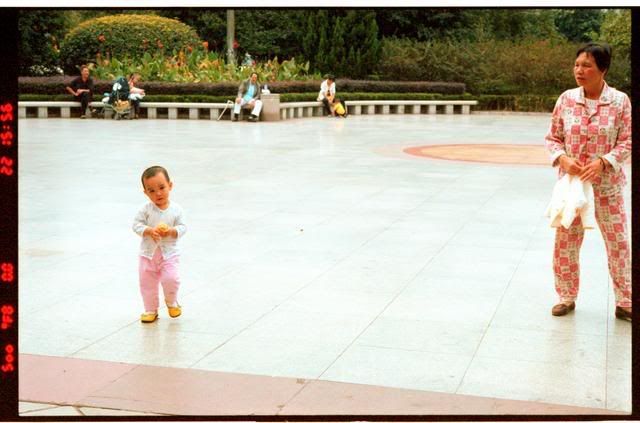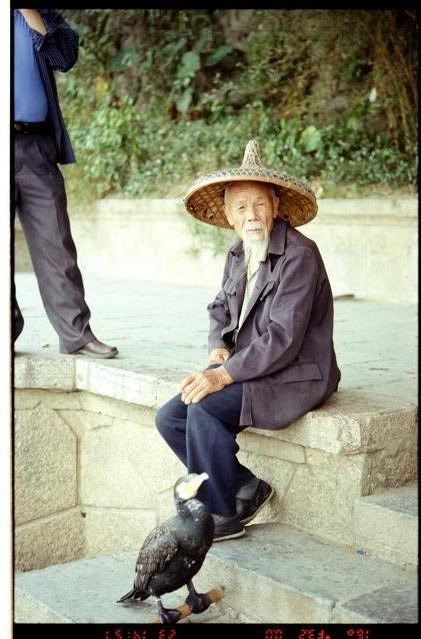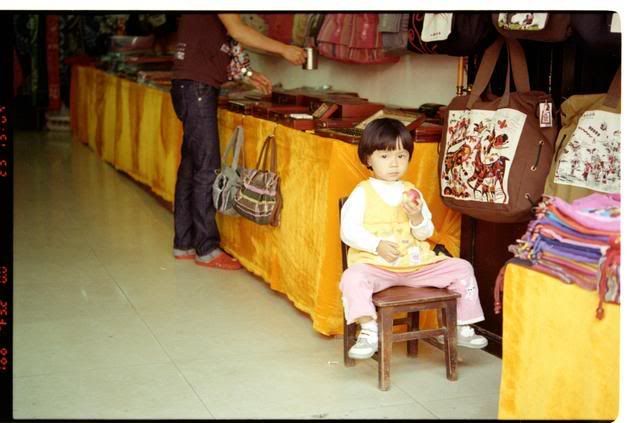I was in China again last week for work, and this trip was significant for me because it was my first chance to truly use my newly acquired Nikon F6 SLR.
It's an amazing camera to say the least -- the ergonomics are simply perfect for my hands. Some comments I read online say that the settings on the camera are complex, but about an hour fiddling with it (with the help of the manual) was all I needed to get everything in order. And after figuring out how to load the film properly (it's been a while), I was all geared up to put the camera through its paces.
Perhaps because of HCB and Ansel Adams, I had always associated film with two things: street photography and landscapes. And maybe fine art photography as well. While I hope to do all three with film, street photography is where I start.

A friendly motorcycle cab shifu I met in Guilin. I wanted to chat a little more with him, but had to re-join my tour group. © Lin Zhaowei, 2009.

It's quite funny when I would lower my camera after taking a shot to look at the back. But sorry, there's no image review in film, even on the most advanced bodies! I find that it wasn't really a handicap, partly because I trust the F6's metering and partly because that's part of the reason why I decided to turn to film. And the initial results are encouraging.

An old man at the jetty in Yangshuo. You can pay a few yuan to take photos with his birds. On hindsight, perhaps I should have paid to take a photo of him! © Lin Zhaowei, 2009.

A little girl in a shop along Yangshuo's tourist trap, the West Street. © Lin Zhaowei, 2009.
It's an amazing camera to say the least -- the ergonomics are simply perfect for my hands. Some comments I read online say that the settings on the camera are complex, but about an hour fiddling with it (with the help of the manual) was all I needed to get everything in order. And after figuring out how to load the film properly (it's been a while), I was all geared up to put the camera through its paces.
Perhaps because of HCB and Ansel Adams, I had always associated film with two things: street photography and landscapes. And maybe fine art photography as well. While I hope to do all three with film, street photography is where I start.

A friendly motorcycle cab shifu I met in Guilin. I wanted to chat a little more with him, but had to re-join my tour group. © Lin Zhaowei, 2009.
One thing I liked about using the F6 is that my favourite lens, the AFS 60mm f2.8, becomes a "normal" lens -- the field of view is close to that of the human eye. Normal lenses have always been popular for that reason. And it's a comfortable focal length for street, as it's wide enough to capture the surroundings and long enough to give some object-background separation.

A little boy and his grandma, outside a park in Guilin. © Lin Zhaowei, 2009.
It's quite funny when I would lower my camera after taking a shot to look at the back. But sorry, there's no image review in film, even on the most advanced bodies! I find that it wasn't really a handicap, partly because I trust the F6's metering and partly because that's part of the reason why I decided to turn to film. And the initial results are encouraging.

An old man at the jetty in Yangshuo. You can pay a few yuan to take photos with his birds. On hindsight, perhaps I should have paid to take a photo of him! © Lin Zhaowei, 2009.
One thing that surprised me was that it's not easy to find film in China nowadays, even in a relatively less developed place like Guangxi. I was lucky to have a photo store near my hotel in Nanning, which sold Kodak Max 200 and Fuji Superia 200. But by the time I arrived at Yangshuo's West Street, I had run out of film. I was immensely relieved that I finally found one photography equipment shop at the very end of the street.

A little girl in a shop along Yangshuo's tourist trap, the West Street. © Lin Zhaowei, 2009.
Actually halfway through my short trip to Guilin, I desperately wanted to buy some B&W film, mainly for the Liqiang cruise. But that proved elusive. I will be stocking up on the Tri-X's next time round! Have already found out where to buy them at a reasonable price in Singapore.




